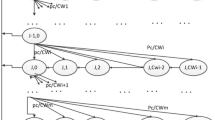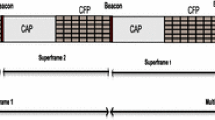Abstract
We model wireless local area network channel utilization over a finite interval through a finite time-horizon Markov (FTHM) model. By accurately capturing time-varying utilization, the FTHM model allows for generally distributed transmission-opportunity (TXOP) duration, which most existing models do not account for. An absorbing state is introduced to limit the lifetime of the counting process, resulting in a non-ergodic Markov chain that is solved via transient analysis. The model predictions for time-varying utilization are validated by simulation with errors of no more than 0.1% after eight beacon intervals. Moreover, we show that the FTHM model prediction error is below 4% for Poisson distributed and uniformly distributed TXOP durations.
Similar content being viewed by others
References
Coenen, T.J.M., van den Berg, J.L., Boucherie, R.J., 2008. Analysis of a Polling System Modeling QoS Differentiation in WLANs. Proc. 3rd Int. Conf. on Performance Evaluation Methodologies and Tools, p.1–8. [doi:10.4108/ICST.VALUETOOLS2008.4394]
Garroppo, R.G., Tavanti, L., Lucetti, S., Giordano, S., 2007. Extension and Application of the Network Utilization Characteristic Metric to IEEE 802.11e in IEEE 802.11e WLAN Networks. Proc. Int. Conf. on Communication, p.1766–1771. [doi:10.1109/ICC.2007.295]
Gozalvez, D., Monserrat, J.F., Calabuig, D., Gozalvez, J., 2007. Policy-based channel access mechanism selection for QoS provision in IEEE 802.11e. IEEE Vehic. Technol. Mag., 2(3):29–34. [doi:10.1109/MVT.2008.915326]
Hu, J., Min, G., Woodward, M.E., Jia, W., 2008. A Comprehensive Analytical Model for IEEE 802.11e QoS Differentiation Schemes under Unsaturated Traffic Loads. Proc. Int. Conf. on Communication, p.241–245. [doi:10.1109/ICC.2008.52]
IEEE Std 802.11, 2007. IEEE Standard for Information Technology—Part 11: Wireless LAN Medium Access Control (MAC) and Physical Layer (PHY) Specifications, p.C1–1184. [doi:10.1109/IEEESTD.2007.373646]
IEEE Std 802.11-k, 2008. IEEE Standard for Information Technology—Part 11. Amendment 1: Radio Resource Measurement of Wireless LANs, p.C1–222. [doi:10.1109/IEEESTD.2008.4544755]
Karagiannis, T., Molle, M., Faloutsos, M., Broido, A., 2004. A Nonstationary Poisson View of Internet Traffic. Proc. 23rd Conf. on IEEE Computer and Communications Societies, 3:1558–1569. [doi:10.1109/INFCOM.2004.1354569]
Lee, J.Y., Lee, H.S., 2009. A performance analysis model for IEEE 802.11e EDCA under saturation condition. IEEE Trans. Commun., 57(1):56–63. [doi:10.1109/TCOMM.2009.0901.060395]
Lim, J.H., Yun, J.H., Seo, S.W., 2008. Throughput Model of IEEE 802.11e EDCF with Consideration of Delay Bound Constraint. Proc. Int. Conf. on Communication, p.235–240. [doi:10.1109/ICC.2008.51]
Panaousis, E.A., Frangoudis, P.A., Ververidis, C.N., Polyzos, G.C., 2008. Optimizing the Channel Load Reporting Process in IEEE 802.11k-enabled WLANs. Proc. 16th IEEE LANMAN, p.37–42. [doi:10.1109/LANMAN.2008.4675841]
Sharon, O., Altman, E., 2001. An efficient polling MAC for wireless LANs. IEEE/ACM Trans. Networking, 9(4):439–451. [doi:10.1109/90.944342]
Sikdar, B., 2005. Delay Analysis of IEEE 802.11 PCF MAC Based Wireless Networks. Proc. IEEE GLOBECOM, 1:556–560. [doi:10.1109/GLOCOM.2005.1577686]
Xu, D.X., Sakurai, T., Vu, H.L., 2009. An access delay model for IEEE 802.11e EDCA. IEEE Trans. Mob. Comput., 8(2):261–275. [doi:10.1109/TMC.2008.108]
Zhang, W., Sun, J., Liu, J., Zhang, H.B., 2007. Performance analysis of IEEE 802.11e EDCA in wireless LANs. J. Zhejiang Univ. Sci. A, 8(1):18–23. [doi:10.1631/jzus.2007.A0018]
Author information
Authors and Affiliations
Corresponding author
Rights and permissions
About this article
Cite this article
Kuan, C., Dimyati, K. Finite time-horizon Markov model for IEEE 802.11e. J. Zhejiang Univ. Sci. A 10, 1383–1388 (2009). https://doi.org/10.1631/jzus.A0920170
Received:
Accepted:
Published:
Issue Date:
DOI: https://doi.org/10.1631/jzus.A0920170




